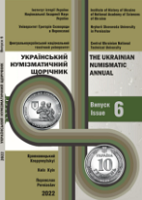КОРПУС МОЛОДШИХ НОМІНАЛІВ ОЛЬВІЙСЬКОЇ КАРБОВАНОЇ МІДІ ПЕРШОЇ ПОЛОВИНИ IV СТ. ДО Р. Х.
CORPUS OF SMALL DENOMINATIONS OF OLBIAN MINTED COPPER COINS OF THE FIRST HALF OF THE 4th CENTURY BC.
Author(s): Yevgeniy KolesnichenkoSubject(s): Archaeology, Cultural history, Economic history, Ancient World
Published by: ДВНЗ Переяслав-Хмельницький державний педагогічний університет імені Григорія Сковороди
Keywords: Olbian coinage; small denominations of minted copper coins of Olbia; corpus of coins;
Summary/Abstract: Introduction and historiography. I.P. Blaramberg initiated the research of Olbian coins. He described various types of coins for the first time, including small denominations, which are the objects of study in this article. Subsequently, the most complete descriptions of these coins were published by V.A. Anokhin and P.O. Karyshkovsky. However, unfortunately, these works do not provide a complete picture of the role played by small denominations in Olbian numismatics, as well as their interconnection. This promoted a creation of the corpus of coins, based on their stylistic and metrical analysis. The theoretical and methodological basis of the study is a set of numismatic methods, e.g., the methods of visual analysis, identification and typological classification of coins, as well as comparative method. The purpose of the article is to systematize small copper coin types and their varieties issued in the first quarter – mid-4th century BC, and the compilation of their catalog. 53 coin types of small denominations and their varieties were identified by the author. The chronological framework of the examined corpus covers the period from the beginning of copper minting in the first quarter of the 4th century BC to the appearance of "obol series" in the mid-4th century BC. All coins have been divided into four groups. Each group, with the exception of the third one, is represented by small, middle and large denominations. All coins of the third group belong to the same denomination. Taking into account that their weight ranges between 0.8 and 1.1 g, they were conventionally attributed to small denomination. The first group of the studied corpus is represented by coins of large denomination (no. 1) and its fractions – four types of middle denomination (nos. 2–5) and four types of small denomination (nos. 6–9). The second group consists of two denominations: large (nos. 10–15) and small (nos. 16–21). The third group is represented by only two coins of the same type (nos. 22–23), and today it remains rather understudied due to its rarity. The fourth group is the largest in number and includes two coins of large (nos. 24–25), two coins of middle (nos. 26–27) and 26 coins of small denominations (nos. 28–53). Noteworthy is the small denomination, on which additional symbols appear, e.g., a bow, a grain, an arrow and an ear of corn, which appear on the coins both separately and in various combinations. Conclusions. For the first time, the author made an attempt to fully cover all small copper coin types and their varieties known today, a total of 53 coins minted from the first quarter of the 4th century BC to the mid-4th century BC. Most of the coins are published for the first time.
Journal: Український Нумізматичний Щорічник
- Issue Year: 2022
- Issue No: 6
- Page Range: 94-108
- Page Count: 15
- Language: Ukrainian

